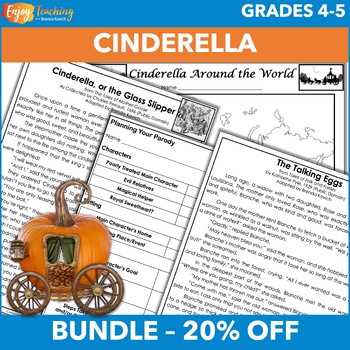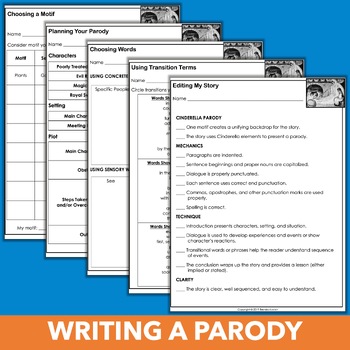Cinderella Unit - Fairy Tale Genre Study for Fourth and Fifth Grade Students
- Zip
- Easel Activity

What educators are saying
Products in this Bundle (5)
Bonus
Description
Have a ball with this complete Cinderella-themed unit! The bundle includes lesson plans, stories, reading worksheets, comparing fairy tales activities, narrative writing, and three fun-filled projects (story elements cube, creative carriage project, and social media activity).
Open the preview to take a closer look at components of the genre study.
Cinderella Stories
Five tales are available as printable PDFs and an eBook. They have been adapted for fourth or fifth grade readers using modern language.
- “Cinderella, or the Glass Slipper” (France)
- “The Talking Eggs” (Louisiana, USA)
- “Katie Woodencloak” (Norway)
- “Ye Xian” (China)
- “Daisy Della” (parody)
Reading Worksheets
Now you can add standards-based literature skills to your unit!
- What Is a Fairy Tale? introduction
- Fairy Tale Elements worksheet
- Cinderella comprehension questions for any tale (teacher and student versions)
- Summarizing graphic organizer and page for longer response
- Finding a Theme organizer and page for longer response
- Character Analysis table and page for longer response
- Character Comparison Venn diagram and page for longer response
- Perspective activity – write from a character’s point of view
Comparing Cinderella Around the World
In these activities, the class reads fairy tales from around the world, as well as parodies. Then they analyze elements and discover similarities between folktales in different locales.
- Lesson plans
- Two lists of picture books – one for folklore and the other for parody
- Folklore or parody worksheet (with answer key)
- Comparison tables table (two versions)
- Venn diagrams (for two, three, or four stories)
- Cinderella Around the World (two sheets – one for listing fairy tales by continent, the other for finding similarities between stories from same continents)
Writing Cinderella Parodies
Writing fractured fairy tales ignites kids’ creativity! As they plan parodies, you can reinforce the narrative strategies (e.g., development of characters and plot), dialogue, word choice, transitional words.)
- Planning grid
- Lesson plans
- “Cinderella, or the Glass Slipper” (two-page printable text adapted from Charles Perrault’s version)
- “Daisy Della” (two-page printable original passage)
- “What Is a Fairy Tale?” mini poster
- “What Is a Parody?” mini poster
- Venn diagram for comparing and contrasting stories
- Topic choice graphic organizer
- Planning sheet
- Dialogue mini poster, practice worksheet, and planning page
- Word choice brainstorm sheet (concrete and sensory words)
- Transition terms list
- Editing checklist
- Rubric
Cinderella’s Carriage – Creative Thinking Activity
What if the main character wasn’t a country girl? For this creative drawing or writing project, each student considers a different profession. Then they draw or write about the carriage, horses, coachman, and footmen the fairy godmother would conjure up. For example, what if the main character was a football player or a scuba diver?
Two additional free activities are also included: Cinderella’s Social Media Post and Story Elements Cube.
Sample 15-Day Schedule
This set of lesson plans is included as a bonus file. You may use it or pick and choose resources to create your own unit.
Day 1 – Learning About Story Elements
- Introduce the genre of fairy tales.
- Read "Cinderella, or the Glass Slipper" aloud. Explain that the story has been retold many times; therefore, many versions exist.
- Let students explore Elements of a Story on the Annenberg Learning website. Ask them to take notes.
Day 2 – Exploring the Story Arc and Summarizing
- Discuss similarities and differences of "Cinderella, or the Glass Slipper" and the retelling of the story on the Annenberg Learning website.
- Review elements of a story.
- Watch Summarizing and the Story Arc.
- Map and summarize "Cinderella, or the Glass Slipper" together.
- Optional: Ask students to analyze the story for elements of fairy tales.
- Creative Twist: Cinderella's Carriage - Ask, "What if the main character weren't a country girl?" Ask each student to draw and/or describe the carriage, horses, coachman, and footmen for a different story.
Day 3 – Summarizing
- Ask students to read, map, and summarize "The Talking Eggs."
- Creative Twist: Before they map and summarize, let students construct the Cinderella story element cube. They may then roll it and name the elements.
Day 4 - Finding a Theme
- Ask students to identify ways actions of characters in "The Talking Eggs" affected the outcome. If desired, ask students to express and explain the theme in a paragraph.
Day 5 - Analyzing Characters
- Ask students to determine which characters are good and which are evil in "The Talking Eggs." Record on analyzing characters grid.
- Creative Twist: Have students complete a Facebook-like social media post for one or more characters.
Day 6 – Learning About Parody
- Read "Daisy Della" aloud. Explain that parodies are often-humorous imitations of stories. Use the folktales and parody posters to illustrate the differences.
- Compare and contrast the two stories on the Venn diagram.
- Have students complete the parody or folklore worksheet.
Day 7 – Choosing Topics for Writing Parodies
- Choose a motif.
- Discuss the sample planning page.
- Optional: Read and analyze additional picture books from your library.
Day 8 – Planning a Cinderella Story
- Plan fractured fairy tales with graphic organizers.
- Optional: Read and analyze additional picture books from your library.
Day 9 – Review Writing Dialogue
- Review with anchor chart.
- Practice with a worksheet.
- Plan dialogue for story.
- Optional: Read and analyze additional Cinderella picture books from your library.
Day 10 - Review Word Choice
- Review word choice.
- Plan concrete and sensory words for story.
- Use one-page list of transitions to consider linking words.
- Optional: Read and analyze additional Cinderella picture books from your library.
Days 11-12 - Drafting
- Draft parodies.
- Optional: Read and analyze additional picture books from your library.
Day 13 – Revising and Editing the Cinderella Parody
- Use the editing checklist to revise stories.
- Optional: Read and analyze additional picture books from your library.
Days 14-15 – Publishing the Cinderella Parody
- You may wish to have each student illustrate the story – or format it as a picture book with text and pictures on each page.
- The narrative writing projects make a great display or bulletin board too!
Optional Activities
- Ask students to rewrite one of the stories from a different character's perspective.
- Compare and contrast stories.
- List, compare, or analyze stories from around the world.
Enjoy teaching!
Brenda Kovich





